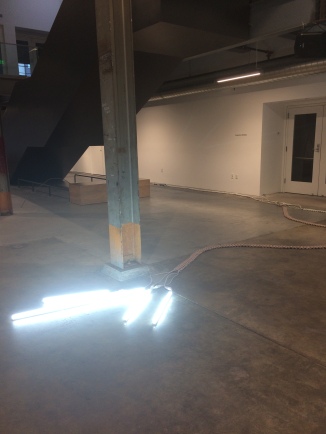Writing with Megan Nicely
We were invited to write a response to Lauren Simpson’s Dance Exhibit, described as “a multidimensional arts experience centered around a physical and embodied exploration of the Atrium space and the sculptures contained within.” Each performance had a different post-show speaker. We were curious about how the dance is extended by including the perspective of Sarah Hotchkiss, the guest speaker on May 10th; when does a dance end? We’ve recently been inspired by The Hundreds, a book by Lauren Berlant and Kathleen Stewart in which each “essay” is written in one hundred words or multiples of one hundred words long.
Upon reflecting, we decided to try out Berlant and Stewart’s hundreds practice as a way to respond to Simpson’s piece. On one hand, this seems like a suitable framework for blogging – – a shorter writing form. On the other hand, it seems to fit, at least to us, how Dance Exhibit displayed meticulous attention to detail not only with the movement quality but also with its relationship to space and sound. Nothing seemed out of place or unnecessary. We each took a different approach with our hundreds practice, yet feel they capture the varied ways we see and write (this) dance.
Artistic Labor, Megan Nicely
I felt strangely idle. Women in colored jumpsuits moved silently and efficiently at the peripheries of audience clumps, repositioning pieces of industrial material–rebar, fluorescent tubes, coils of extension cords–while we chatted. It had started, the performance I mean. The bodies in colored jumpsuits–orange, blue, black, white, green–were already exhibiting the behind-the-scenes labor of installation crews to us, you know, the ways objects are placed in museums and galleries just so. These bodily gestures, measurements, and precision are what make the art object appear just right, and that is what these bodies–these dancers–were doing, and continued to do throughout the piece.

Dance Exhibit, Minnesota Street Project May 2019. Photo Credit: Megan Nicely
At some point we stopped our idle chatter. Maybe it was because the labor force had unified, and displaced us. We watched as the bodies staked their claim on a large wooden staircase, itself part installation, part architecture. Soon we also occupied this space, now a formal seated audience. We observed the art laborers mirror the forms of the art objects down below. I let myself continue the labor installation narrative, seeing the danced actions as a process of gathering information about the objects, so as to know what next to do with them–a way to understand their nature somehow.

Dance Exhibit, Minnesota Street Project May 2019. Photo Credit: Megan Nicely
After the performance, the speaker referred to “ooo”–object-oriented ontology, which means everything existing equally, rather than humans at the top. Did the objects communicate their preferences? Was the human precision a way to contain and manage the situation, to avoid mess or spillage? Clean, even, focused–these are not words we often use to describe labor, yet if a body is to repeat activity for a long time, or remain in relationship, a somatic aesthetic is helpful. Approach touching the material with care. You may not know the past lives that have allowed the things to arrive to this moment.
(“Dance Exhibit” with Lauren Simpson Dance, Dana Hemenway, and Sarah Hotchkiss; Alien Phenomenology by Ian Bogost; Awareness Through Movement by Moshe Feldenkrais)
Space Making, Michelle LaVigne
Walking into Minnessota Street Project, I felt curious and slightly impatient. I read that the dance started at 7:45; I didn’t want to miss anything. People were busy talking, walking, and sitting throughout the space. As we mingled, five dancers dressed in different colored coveralls moved around the open space, manipulating different objects – – glowing fluorescent tubes, macraméd extension cords, and twisted rebar. They moved to the stairs and slowly rolled their way down. We were then directed toward the stairs and sat down to watch the dance continue or was it just beginning? A new start or a resetting?

Dance Exhibit, Minnesota Street Project May 2019. Photo Credit: Michelle LaVigne
The dancers then began to interact directly with the objects; they moved them and moved with them. They also moved like them; sculpting their bodies to mirror their shapes and energy. By taking on these shapes, the dancers activated these objects, suggesting they could be otherwise. The materials and space that might ordinarily seem static became mobilized, pliable. The soundscape performed live by Shanna Sordhal added to this tactile-ness. The dancer’s white shoes echoed through the space, also helping to amplify and alter the very white space. The manipulation of bodies, materials, and sound challenged the stability of expected forms.

Dance Exhibit, Minnesota Street Project May 2019. Photo Credit: Megan Nicely
The end came a bit abruptly; I was surprised to hear clapping from behind; my vision blocked by the I-beams bisecting the space. The shift from dance to words ended the evening with Sarah Hotchkiss, our speaker and then moderator with Simpson and artist Dana Hemenway. We got glimpses into their creative practices and insights into how things (like Hemenway’s macraméd extension cords) come into being, how they have ontological status. It was an insightful end; their conversation left me wondering about space, things, and the power of bodies to move materials into ideas – – are we that different than things?

Dance Exhibit, Minnesota Street Project May 2019. Photo Credit: Megan Nicely